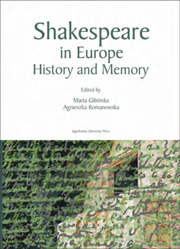Book contents
- Frontmatter
- Contents
- Preface
- Towards a European History of Henry V
- History and Histories
- History and Memory: Criticism and Reception
- “Strictly Ideal:” Shakespeare's Personality as a Historical Construct in Nathan Drake's Noontide Leisure
- Shylock and the Shrew: Victorian Shakespeare and Nineteenth-Century Spain
- “Memory of the Text.” Wyspiański's Hamlet
- “Happily they had no Choice:” Shakespeare's Elizabethan Audience and the Ideal of a Unified Cultural Sphere, C. 1920–1950
- History, Memory, and Ideological Appropriation
- Theatre: The Act of Memory and History in the Making
- Index of Authors
“Memory of the Text.” Wyspiański's Hamlet
from History and Memory: Criticism and Reception
Published online by Cambridge University Press: 05 September 2014
- Frontmatter
- Contents
- Preface
- Towards a European History of Henry V
- History and Histories
- History and Memory: Criticism and Reception
- “Strictly Ideal:” Shakespeare's Personality as a Historical Construct in Nathan Drake's Noontide Leisure
- Shylock and the Shrew: Victorian Shakespeare and Nineteenth-Century Spain
- “Memory of the Text.” Wyspiański's Hamlet
- “Happily they had no Choice:” Shakespeare's Elizabethan Audience and the Ideal of a Unified Cultural Sphere, C. 1920–1950
- History, Memory, and Ideological Appropriation
- Theatre: The Act of Memory and History in the Making
- Index of Authors
Summary
It may be the duality into which the human being is split, suspended between self-preservation and self-transgression, that makes us wander with undiminished fascination in the maze of our own unpredictable possibilities. With literature as Ariadne's thread, human beings try to keep track of their self-exploration, always on the verge of losing themselves between their alternatives.
In his short essay on the nature and making of Renaissance dramatic texts Stephen Orgel describes the process of Shakespearean writing as an amalgam of alteration, interpolation, revision, and collaboration on the part of the playwright, the company and its owners:
The notion of final or complete versions assumed by virtually all modern editors of Shakespeare is inconsistent with everything we know not only about Renaissance theatrical practice, but the way writers in fact work. Poets are always rewriting, and there is no reason to think that many of the confusions in Shakespeare's texts don't involve second thoughts, or amalgams of quite separate versions of a play. […] I have argued that most literature in the period, and virtually all theatrical literature, must be seen as basically collaborative in nature, and I have said that Shakespeare can be distinguished from most other playwrights only because he was in on more parts of collaboration.
- Type
- Chapter
- Information
- Shakespeare in EuropeHistory and Memory, pp. 149 - 162Publisher: Jagiellonian University PressPrint publication year: 2008



